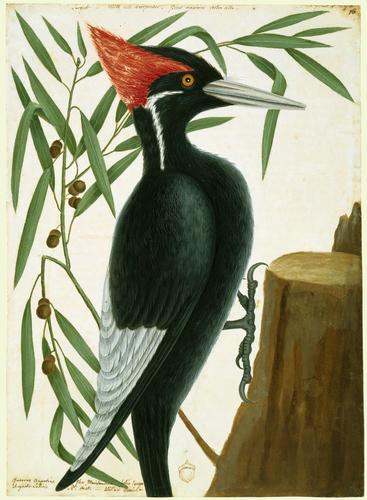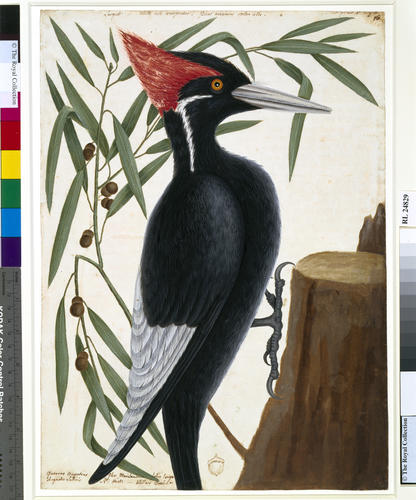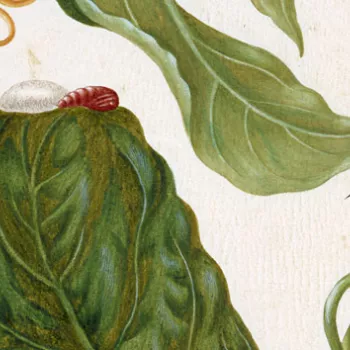The Largest White-Bill Wood-Pecker and the Willow Oak c.1722-26
Watercolour and bodycolour heightened with gum arabic, over pen and brown ink and traces of graphite | 37.5 x 27.1 cm (sheet of paper) | RCIN 924829
-
A watercolour of an ivory-billed woodpecker (Campephilus principalis (Linnaeus)) perched on a log, with a spray of willow oak (Quercus phellos L.). A sketch of the willow oak nut is included at bottom centre. Inscribed in ink: (top centre) 'Largest - white bill woodbecker. Picus maximus rostro albo'; (bottom left) 'Quercus Anpotius Ilex Marilandica folio longo / Angusto Salicis R: Hist: - Willow Oak'; (top right) '16'
Mark Catesby was born in Suffolk and was interested in natural history from an early age. In 1712, he travelled to the east coast of America with his sister Elizabeth, who had married a doctor who practised in Williamsburg, Virginia. Catesby spent seven years in Virginia collecting specimens and seeds for London buyers before returning to Britain. In London his drawings of birds and plants met with praise and a group of benefactors paid for his travel to Carolina in 1722. There, he made numerous drawings of the flora and fauna, working hard to ensure that his depictions were as helpful for an understanding of their subjects as possible. On his return to Britain, his drawings were reproduced in The Natural History of Carolina, Florida and the Bahama Islands, which appeared in a series of volumes between 1729 and 1747. The first volume was dedicated to Queen Caroline, the second to Augusta, Princess of Wales. The original drawings from the volumes, which had been in the possession of Catesby’s widow until her death, were purchased by George III from the London bookseller Thomas Cadell in 1768.
Catesby used this drawing as the basis of plate 16 in volume 1 of the Natural History ('The largest white-bill Wood-pecker' and 'The Willow Oak'). He would have encountered the spectacular ivory-bill, the largest species of woodpecker, in the forests of Florida and in the Bahamas. By the 1950s it was thought to be extinct but recently there have been reported sightings of the bird and there are hopes that the species has survived.
For identification of the species depicted see James L. Reveal, ‘Identification of the plants and animals illustrated by Mark Catesby for his Natural History of Carolina, Florida, and the Bahama Islands’ in Phytoneuron 2013 and revised online version.
Provenance
Thomas Cadell; from whom bought by George III, 1768
-
Creator(s)
Acquirer(s)
-
Medium and techniques
Watercolour and bodycolour heightened with gum arabic, over pen and brown ink and traces of graphite
Measurements
37.5 x 27.1 cm (sheet of paper)
Other number(s)
RL 24829Alternative title(s)
Picus Maximus rostro albo; Quercus Anpotius; Ilex Marilandica, folio longo, angusto, salices










